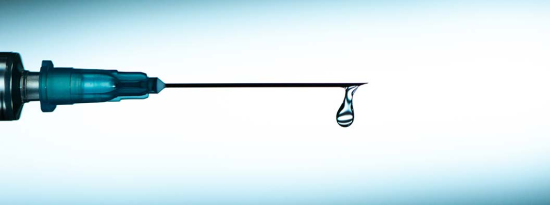Test of a new 'germline-targeting' HIV vaccine prepares to launch
MAY 19, 2022 • BY SABIN RUSSELL / FRED HUTCH NEWS SERVICE

Stock photo by Getty Images
Since 2013, Dr. Leo Stamatatos has been developing a different kind of HIV vaccine intended to train a person’s immune system to mount a powerful antibody response against the virus that causes AIDS.
Now, after nine years of refinement at Fred Hutchinson Cancer Center, it is nearly ready for its first phase of testing in human volunteers.
The trial, which will be run by the Hutch-based HIV Vaccine Trials Network under the name HVTN 301, will enroll 52 participants at six sites across the U.S., including at the Vaccine Trials Unit in Seattle. Pending approvals by review boards at those sites, enrollment in the trials could begin in early July.
Aside from assuring the safety of the vaccine, the trial will analyze how B cells — the antibody-making blood cells in the immune systems of participants — respond to the vaccine’s ingredients. The most important is a tiny protein, or immunogen, engineered by Stamatatos and his team.
“It is great to see this immunogen enter clinical trials,” said Dr. Larry Corey, the Fred Hutch virologist who is principal investigator for HVTN. “And it is great to see the creativity of Leo’s group in building this vaccine candidate.”
Curious About HIV Clinical Trials?
HVTN's first-of-its-kind national registry provides updated HIV information and makes it easier to learn about and participate in HIV clinical trials.
Learn more at HelpEndHIV.org
By itself, the Hutch immunogen is not capable of stopping HIV. If it performs as hoped, it would be first of a series of at least three slightly different vaccines. Given in a stepwise sequence, the series is designed to coax the body’s immune system into making “broadly neutralizing antibodies,” a rare breed of freakishly powerful immune proteins better equipped to block the virus.
Broadly neutralizing antibodies are so named because they bind to the surface of HIV in places that this virus — a shape-shifting master at immune evasion — cannot easily sidestep. HIV escapes antibodies by rapidly mutating, but the mutations it would need to slip past broadly neutralizing antibodies can be damaging to the virus itself.
While scientists believe that several types of broadly neutralizing antibodies are capable of stopping HIV, the challenge has been to get the body’s B cells to make them following vaccine stimulation. They do not come easily. In fact, they have never been generated by traditional HIV vaccines, none of which have successfully prevented infection in four decades of study.
HVTN 301 is among the first studies in the world to try out this next-generation vaccine concept known as germline targeting. The strategy involves cultivating rare lineages of B cells that, while lacking the right stuff to make broadly neutralizing antibodies on their own, are close to doing so. The successive vaccines drive the maturation, or evolution, of the B cells until they can bring the desired antibodies across the finish line.

Fred Hutch researcher Dr. Leo Stamatatos has been leading development of a vaccine designed to elicit 'broadly neutralizing antibodies' to block HIV since 2013.
Photo by Robert Hood / Fred Hutch News Service
“Our germline-targeting immunogen targets a class of broadly neutralizing antibodies, called VRC01, that have similar characteristics, but are not identical,” Stamatatos said. Within that class, there might be hundreds of slightly different versions of those VRC01 antibodies, making it even more difficult for the virus to evade them through mutations.
VRC01 antibodies were first identified in 2010 from the blood of people who had been living with HIV for several years. These powerful immune proteins had developed and evolved naturally in these patients, but apparently too late to help their exhausted immune systems overcome the infection. Yet lab tests suggest these broadly neutralizing antibodies have the potential to prevent new infections. So, the key is to coax the immune system into making these antibodies — after vaccination — in the absence of infection.
In 2013, Stamatatos began studying an HIV protein, known as 426c, isolated by HVTN researchers from the blood of participants in a South African vaccine trial. In its natural form, this protein could not stimulate production of VRC01 antibodies. However, during the next four years Stamatatos and his team engineered several changes to 426c. With those structural tweaks, the protein triggered the growth of rare VRC01-precursor B cells — the founding generation of immune cells that could evolve, in stages, into makers of broadly neutralizing VRC01 antibodies. Stamatatos had his immunogen.
“No one in the field knows how these VRC01 antibodies got their start,” Stamatatos said. “So, we had to come up with new ways to design this vaccine that does the trick. Our immunogen was designed specifically to activate particular B cells, and we used preclinical testing to prove this was working. Now we want to learn how it actually works in humans.”
Those B cells activated by the immunogen are the (germline) precursors with potential to mature, with additional pushes, into makers of broadly neutralizing antibodies. Stamatatos said his team has already designed, and has started manufacturing, a second immunogen. If a trial proves the first has done its job, the second can be tested in a similar type of trial, to nudge the line of B cells further on the desired evolutionary path. He suspects that a third immunogen, yet to be designed, will be needed to complete the process.
'It is great to see this immunogen enter clinical trials ... and to see the creativity of Leo’s group in building this vaccine candidate.'
— Virologist Dr. Larry Corey, principal investigator and co-founder of HVTN
The trial will also be testing a first-of-its-kind method of delivering vaccines. Half of those enrolled will receive a single dose of the vaccine at the start, but the other half will get their initial inoculation through a series of six mini-doses, spread over two weeks. Starting with a dose that is just 2% of the amount given to others in the single shot, the dosages more or less double in each successive mini-shot — so their last injection will bring the combined total to 100% — the same as the others received at once.
This “fractionated dosing” regime, pioneered by Drs. Shane Crotty of the La Jolla Institute for Immunology and Darrell Irvine at the Massachusetts Institute of Technology, has been tried in animal studies and produced a much more robust immune response than the single injection. The theory is that the incremental increases in dosages prolongs the process through which antibody-making B cells respond to the immunogen, resulting in higher production of the desired antibodies.
“It’s a different concept of immunization,” Stamatatos said. “It’s based on work that has been done in animals, but it has never been done in people. We’re going to test this with our immunogen in humans.”
Hutch lab will be analyzing immune response
HVTN 301, which is funded by the National Institutes of Health, is designed to be small and quick, to prove whether or not the approach is on the right track. Much of the focus of the trial will be on studying blood and lymph specimens from the volunteers. The Hutch laboratory of Dr. Julie McElrath, senior vice president and director of the Vaccine and Infectious Disease Division and holder of the Joel D. Meyers Endowed Chair, specializes in measuring the immune responses to vaccines. It will play a key role in analyzing specimens and data from this trial.
Her lab participated in a similar study of an immune protein designed to produce broadly neutralizing antibodies through a multi-step, germline-targeting approach. The immunogen in this trial was designed by Scripps Research immunologist Dr. William Schief, in La Jolla, California, and the trial was run by Scripps and the New York-based International AIDS Vaccine Initiative, a nonprofit vaccine development organization. In February, the team reported success in this first step. Their immunogen stimulated a group of B cells that, after exposure to a succession of immunogens in the future, might lead to production of broadly neutralizing antibodies.
Fred Hutch staff physician Dr. Will Hahn, who helped design and shepherd HVTN 301 through the regulatory process, said trials like these are important to test out some fundamental concepts of how a vaccine can be made to induce these antibodies.
“It is generally acknowledged that broadly neutralizing antibodies are very, very challenging to induce,” he said. “But it’s always been planned that, if a particular protocol is successful, you can sort of kick-start the race towards neutralization.”
Similarly, Hahn said that it is important to test the idea that slow, incremental dosing of vaccines might be superior to a single shot, to get the kind immune responses needed. He said that the six-shot fractionated regimen is not a practical idea for vaccinating populations, but if the principle of slow, incremental dosing is proven, engineers can figure out a way to make it work later.
“There are all kinds of different methods to do this,” Hahn said. “There are little pumps you can wear, there are patches that deliver drug, like nicotine patches. But to get people who can make those things interested, you have to show them data that says, ‘Hey look, this really works.’”
The altruism of volunteers
Dr. Hyman Scott, an HIV physician at the University of California, San Francisco and at that city’s Department of Public Health, is chair of the protocol team for HVTN 301. He said he was excited about the prospects for this new approach to HIV/AIDS vaccines, because success has been elusive so far.
“We need to explore new and innovative ways to elicit immune responses,” he said. “It’s going to take a complicated solution.”
As a doctor who has been engaged in recruiting volunteers for HIV prevention trials, he said he is hopeful there will be little difficulty finding participants for this new study, even though the trial team will make it very clear to them from the start that there is no expectation this vaccine will prevent HIV.
Half the participants will be assigned to receive the single, full-dose shot of the vaccine, while the other half will be assigned to the incremental doses, which will require six visits in two weeks for the shots alone. Per protocol, all participants will receive a single booster shot three months into the trial.
As is typical for such studies, two participants in each arm of the trial will be randomly chosen to receive a placebo, so no one can be sure they will be receiving the immunogen, at whatever dosage regimen they are assigned.
In addition, the volunteers will return for regular blood draws to measure how their immune systems have responded. Despite the study’s demands, Scott believes the desire to help remains strong.
“I’m always inspired by the altruism of our volunteers, and I am mindful of what we are asking them to do. But if it is something new and exciting and interesting, people will be up for it,” he said.
Source: FRED HUTCH
https://www.fredhutch.org/en/news/center-news/2022/05/hiv-vaccine-germline-stamatatos.html
For more HIV and AIDS News visit...
Positively Positive - Living with HIV/AIDS:
HIV/AIDS News
|